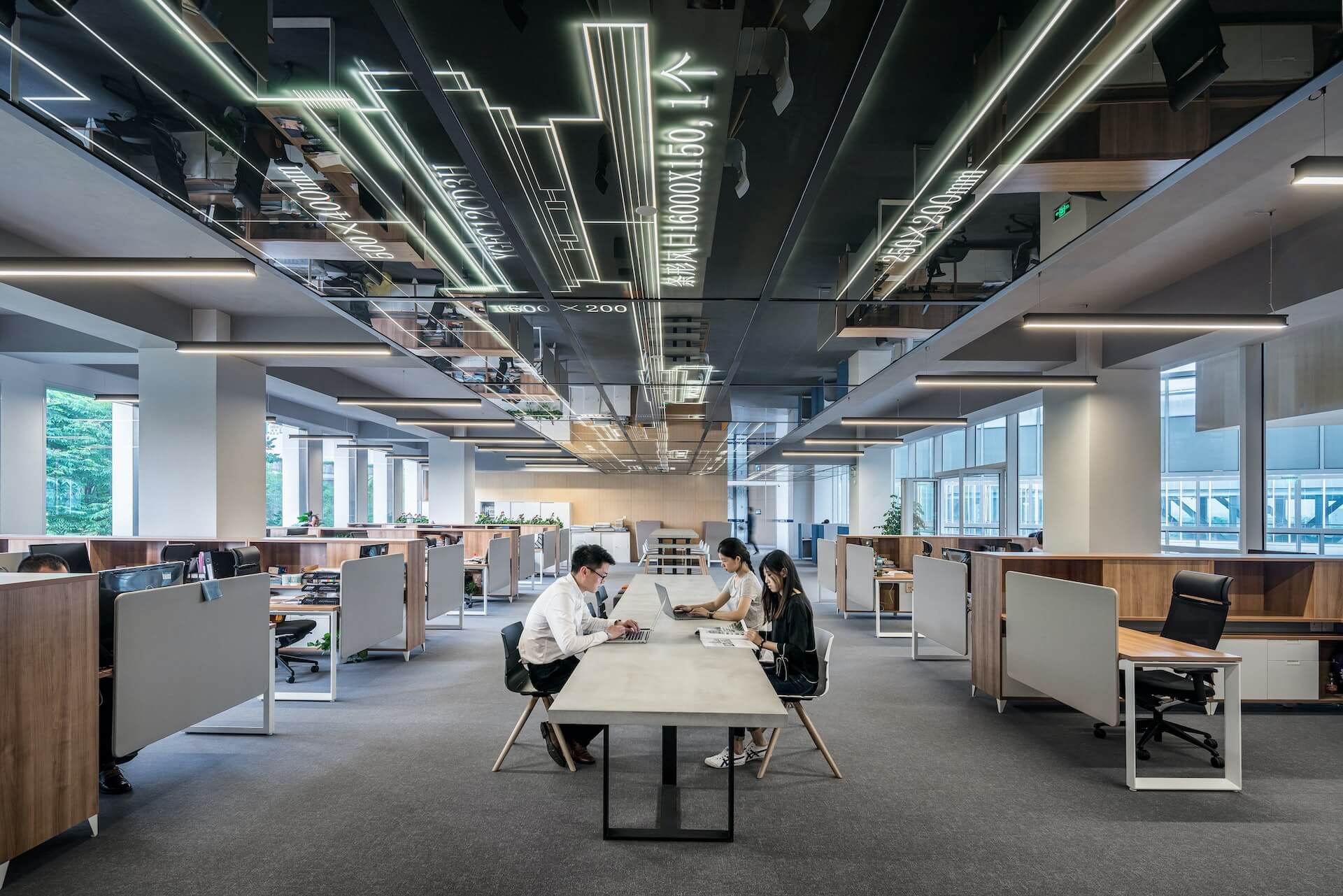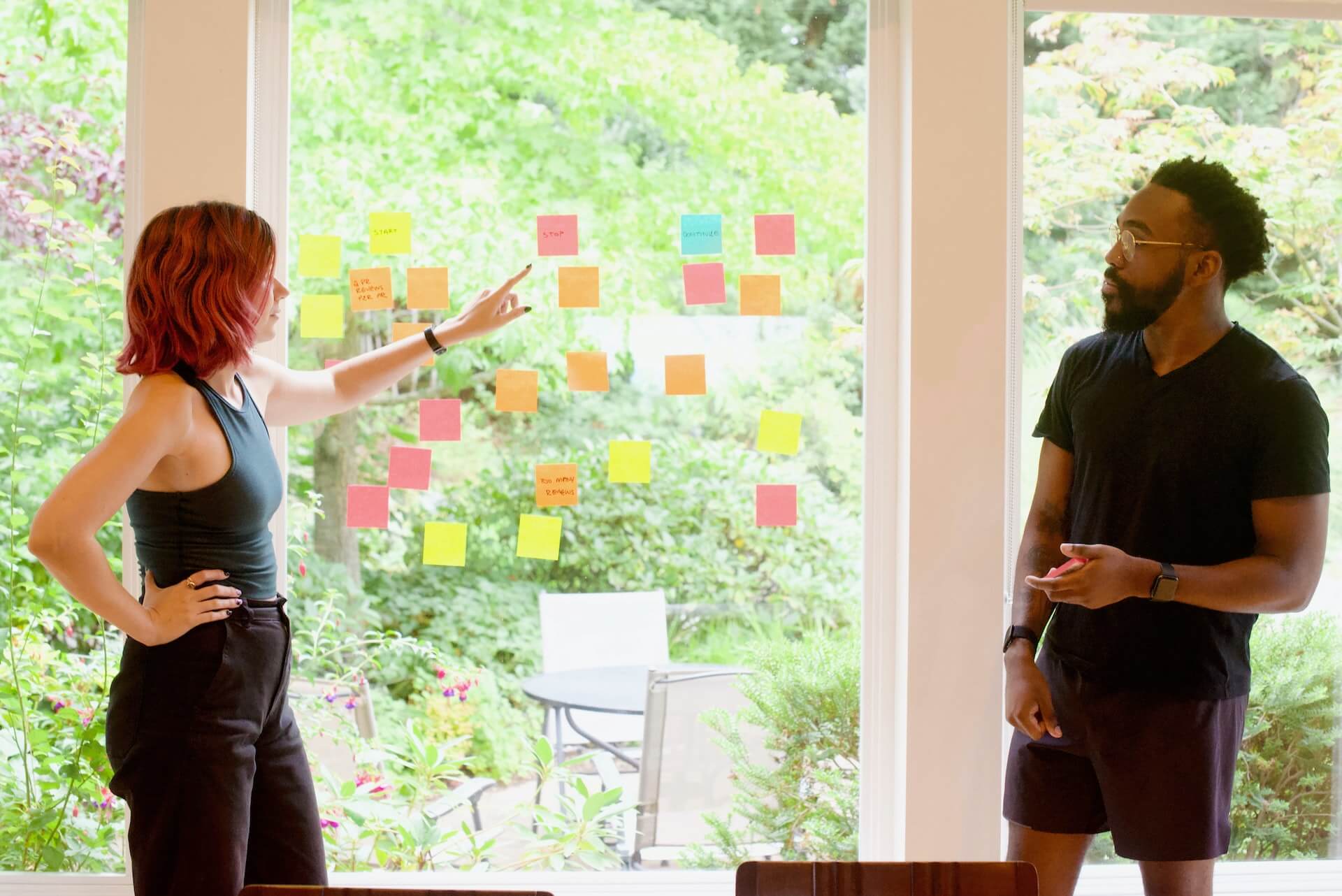Mention open plan offices at the water cooler and you’re sure to spark debate. Opinions on them have always been divided. But a new trend—the hybrid workforce—has cast the much-maligned open office back in the limelight. Companies are responding to the rise of ‘flexible’ workers by removing redundant offices and increasing open floor areas.
However, the role of this office space has changed. In the old model, employers expected people to go into offices to work and be efficient. In that view, the distractions linked with open plan offices hurt satisfaction and productivity.
Today, though, open plan offices are being touted as a solution to pandemic-era isolation and loss of collaboration. Whatever your opinion on this, it’s worth noting that many workers are being recalled to open plan offices. Hybrid work or no, open floor plans still plague us. With that in mind, are there steps we can take to make them more conducive to our well-being?
Can We Redesign Open Plan Offices Using Behavioral Science?

Luckily, research from behavioral science gives insight into how companies can better support open-office workers’ needs. Below, we outline strategies supported by behavioral science to enhance open workplace well-being and productivity.
1. Design for Limited Attention: Reduce the Noise

When it comes to open office complaints, disturbance due to noise is one of the biggest. And it’s easy to understand why. The cognitive psychology literature has provided conclusive data on the deleterious effects of background noise, which can be particularly counter-productive for some employees. It’s no wonder that noise distracts us. After all, our attentional resources are limited.
The facts show clearly that we’re not made for multitasking: drivers who are using their phone are more likely to get in car accidents, and doctors who focus on a patient’s self-reported symptom may miss other important signs and symptoms. No wonder your co-workers’ Zoom calls derail your concentration! Aside from noise-canceling headphones, how can we make this situation better?
Design an Environment to Reduce the Buzz
Let’s start with the obvious. Dial down background noise through smart design decisions. Unanswered phone calls? Divert them to a central answering service. Noise pollution from computers, equipment, or meetings? Quiet it down by masking sound through acoustic panels or providing enclosed booths for Zoom calls. Thoughtful planning of the office area can ensure that employees who need to work quietly sit far away from noisy office equipment or co-workers.
Transform Norms around Noisiness
The fix isn’t just physical. It’s also about changing social norms. Although most flex working spaces already provide designated quiet areas, the key is to create clear social norms around their usage – much like a library or quiet train car. To build new norms around noise reduction, have hard conversations around expectations in different spaces. Craft policies that reserve space for focused working. Build awareness to create a culture that honors quiet time and recognizes that even small breaks of silence help to rejuvenate us.
And while we’re at it – let’s shift norms around meetings, too! Sure, we want fewer meetings, but what we really need are better meetings. Dan Ariely’s view here: don’t have meetings on multiple platforms – virtual and in person. Why? If 4 people are in person and 3 are on Zoom, the latter become second-class citizens. They have to fight to assert themselves, and miss vital communication cues. The solution: push everyone to one format. Either have everyone come in on one day or have the whole team join virtually, regardless of location. Don’t split the difference. Open plan offices are already a compromise. Why add more?
2. Mitigate Uncertainty Around Interactions

A related barrier to productivity is interruptions from co-workers—or rather, the uncertainty around being interrupted. It’s not that co-workers are constantly interrupting each other from focused work (we’re actually quite good at gauging whether someone’s in the zone. But in an open-office, we’re always available, and thus extra protective of our focus.
This leads us to over-compensate by being on alert to fend off and avoid interruptions. So people wear headphones – the universal ‘do not disturb’ social signal that literally prevents communication and connection. This extra vigilance may explain some counterintuitive results from a Harvard study, which found that face-to-face interactions fell by 70% when companies switched to open office plans. What can companies do to better mitigate stress and uncertainty around interruptions?
Give People the Illusion of Control Over Their Availability
Even if co-workers are good at reading signals of business, having clear visible signals reduces anxiety around uncertain interruptions. Having jurisdiction over a clear visible signal helps us feel more in control of our environment, which in turn reduces stress.
Think simple cues like colored chips or lights – red for ‘do not disturb’, yellow for ‘open but prefer to focus’, and green for ‘open to collab’. While a colored cue can’t literally prevent someone from interrupting your flow in an open plan office, they can bring peace of mind.
3. Lean into the Psychology of Connectedness

There’s plenty to criticize about open plan offices. But are there also positives? If so, how can we apply behavioral science to emphasize them while mitigating negatives? For starters, the role of office design in facilitating social connection is too important to overlook. Research on the psychology of connection shows that it can drive both individual well-being and long-term benefits for a company’s workforce.
From the company’s perspective, increasing workforce connectedness directly impacts performance. In fact, a Gallup poll found that having a work bestie doubles employees’ level of engagement with their work and stress resistance in tough situations. Office friendships build resilience that improves work quality. From the worker’s perspective, research shows that even minimal social interaction like greeting, smiling, or engaging in brief conversation can boost happiness. This is true both for the initiator and the recipient of social interaction.
But despite some benefits, we tend to overlook the importance of social interaction for our well-being and sense of purpose at work. Worse, numerous psychological biases push us towards risk aversion when it comes to forming social connections. For example, we tend to believe that we are more interested in conversation than others, so our default is to leave others alone (pluralistic ignorance) and we underestimate how much our conversation partners like us after interactions (liking gap).
Couple these biases with our desire to manage impressions and avoid disruptions, and open plan offices start to look fairly anti-social. Knowing this, how do we design pro-social open plan offices?
Enable Better Social Coordination
If the office is being designed intentionally, we need to be intentional about when these connections are made. We should set aside dedicated times that prioritize in-person and protect that time as fundamental to feeling like a team. Think coordinated coffee breaks or lunches.
To build better connections between people, we first have to ensure that those people are in the same place at the same time. To that end, it can help to be more prescriptive (or paternalistic) about when people are in the office (at least on the level of days, not necessarily minutes).
Promote Better Social Scripts
Returning to the open plan office means an opportunity to set new scripts of engagement. Promoting social hours or coffee chats at the office allows people to talk about things beyond work. One way to set up new social scripts is to be more prescriptive at the start. Providing conversation starter cards, for example, helps to solidify new norms and importantly shift our default from just ‘talking shop’.
4. Build a Structure for Creative Collaboration

In addition to building social connections, open plan offices are supposed to foster spontaneous work collaboration and innovation. The plethora of virtual whiteboard platforms have certainly made collaboration easier, and while we are big fans of Miro, it doesn’t replace a physical white board. The level of collaboration just isn’t the same. Open plan offices can solve that gap by facilitating joint attention and group synchrony.
When physically together, there can be a literal and physical sense of pursuing a shared goal that enriches collaboration in a way that’s not possible virtually or in a closed environment. Well-designed public spaces can also be good for social facilitation. The idea here isn’t that you’re being watched so you have to be productive, it’s that things can actually feel easier when others around you are doing the same thing (like how exercising can feel easier at a gym).
The problem? An open plan office can also limit innovation. We’re less willing to experiment when potential failure feels very public. How can we overcome this barrier?
Solution: Reinforce Process Over Results
If the walls are going to stay down, we need to address the ‘creativity tax’ that open floor plans place on people — the loss of a safer way to experience small failures. To reduce our aversion to trying new things in public, organizations can look to their embedded incentive structures for change.
When KPIs center around results (e.g. number of sales per quarter), people tend to seek the path of least resistance to success, leaving no room for experimentation and creativity that foster long-term growth. Firms that redirect focus towards process-oriented indicators like ‘spend 20% of your time learning’ can set an implicit norm for embracing a windy path strewn with small failures that nurture individual creativity and, ultimately, drive innovation.
5. Increase Choice and Agency

There’s no one-size-fits-all approach to open office design. Some jobs require more silence and privacy, while others thrive on collaboration. Some of us can tune out background buzzing, while more sensory-friendly environments make it easier for neurodivergent employees to participate in the workforce. So how can we design an open-office environment that accounts for everyone’s needs?
Solution #1: Gather Data
Employers should survey employees company-wide to gather their opinions on open office design and barriers to productivity. Research should include a representative sample, not just a few key decision-makers. Employees should easily be able to give feedback and raise complaints—and these should be taken seriously.
Solution #2: Maintain Freedom of Choice
Each team sets the rules and expectations for themselves. The optimal working space must provide enough diverse, activity-specific spaces to ensure that individual workers and teams can find the environment that best suits their needs. Yes, this means flex spaces like huddle rooms, closed booths and open gathering rooms to suit different levels of collaboration.
The Wrap on Open Plan Offices

As more people return to the office, open plan offices are due for a revisit to improve both work outputs and personal well-being. This creates a window of opportunity for making changes. Whether you’re a manager, employee, workplace designer, or care about employee well-being, we encourage you to think beyond the logistically complicated, status quo-driven physical changes and towards behavioral design improvements that can truly make difference.
While we can’t predict what future research might contribute to the debate, we hope that this behavioral perspective adds nuance to the conversation as we continue to iterate on improving our working lives.
Need help solving workplace-health-related challenges, or designing workplaces behaviorally? Contact us to learn more—we’d love to chat!